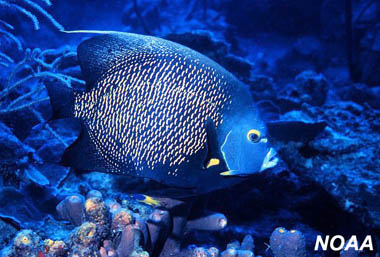
Pomacanthus paru
These flat, oval shaped fish have large trailing dorsal and anal fins, the dorsal having a bright yellow margin and filament. They are generally dark to black with their body scales edged in bright yellow, and with yellow on their pectoral fins, white around their mouths, and yellow around their eyes. The juveniles are much darker, with bright yellow bands that fade as they age, and rounded fins that square and get pointed as they get older. These angel fish form monogamous breeding pairs and are territorial to their home area. They are a popular and hardy aquarium fish, and also a food fish.
Order – Perciformes
Family – Pomacanthidae
Genus – Pomacanthus
Species – paru
Common Names
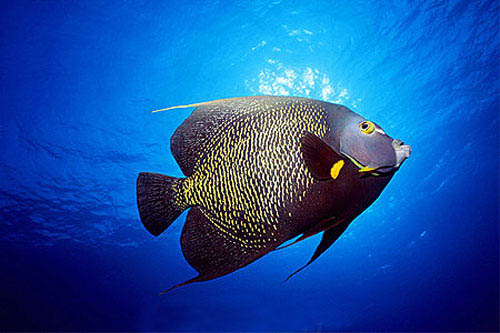
English language common names include angelfish, French angelfish, and French angel. Other common names are banderita (Spanish), cachama negra (Spanish), chivirica francesa (Spanish), demoiselle chiririte (French), enxada (Portuguese), frade (Portuguese), fransk kejserfisk (Danish), jandaia (Portuguese), kihoshi-yakko (Japanese), paru (Portuguese), paru-de-pedra (Portuguese), paru-listrado (Portuguese), paru-preto (Portuguese), peixe frade (Portuguese), and ustniczek czarny (Polish).
Importance to Humans
The French angelfish is considered good quality for human consumption. It is marketed fresh in Singapore and Thailand, however it has been linked to ciguatera poisoning. This fish has also been successfully raised in captivity. Highly prized for public and private aquaria, the French angelfish is a very hardy, long-lived, and disease-resistant species.
Conservation
> Check the status of the French angelfish at the IUCN website.
The IUCN is a global union of states, governmental agencies, and non-governmental organizations in a partnership that assesses the conservation status of species.
Geographical Distribution
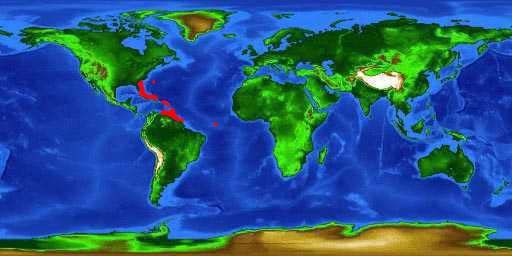
The French angelfish occurs in the western Atlantic Ocean from Florida and the Bahamas, south to Brazil. Its range also includes the Gulf of Mexico and the Caribbean Sea, including the Antilles. On rare occasion it has been found off the coast of New York. The French angelfish has recently been introduced to the waters around Bermuda. In the eastern Atlantic Ocean, it is found off Ascension Island and St. Paul’s Rocks.
Habitat
Usually found at depths less than 15 feet (4.5 m), the French angelfish lives in coral reef areas that offer shelter from nocturnal predators. It is a very territorial fish, often occurring in pairs. However, it is also very curious and swims close to divers and snorkelers.
Biology
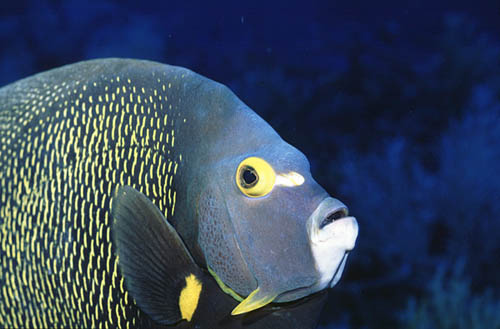
Distinctive Features
The French angelfish has a thin, deep body with a small mouth and comb-like teeth. The lower jaw protrudes past the upper jaw. There is a prominent spine at the corner of the preopercle bone. The edge of this spine is serrate in juveniles and smooth in adults. The pectoral fin, when depressed, extends past the base of the anal fin. The caudal fin has a nearly straight terminal edge in the adult fish.
Coloration
The scales on the body are black and rimmed with a bright golden yellow. There is a broad orange-yellow bar at the base of the pectoral fins and a yellow filament in the dorsal. The chin appears whitish. Eyes are narrowly edged in blue with a yellow outer portion of the iris. All fins are black. Juveniles differ greatly from the adult coloration. The juveniles are distinguished from the adults with a dark brown to black body with three thick vertical yellow bands that continue onto the fins. As the juvenile matures, the scales resemble those of the adult – black with yellow edges – throughout the body except those near the front of the fish which remain black. It also loses the vertical yellow bands except for the yellow-orange bar at the outer base of the pectoral fin. The dorsal filament turns yellow.
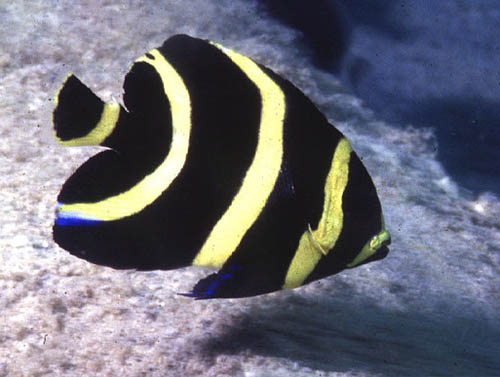
They are similar to juvenile gray angelfish (Pomacanthus arcuatus) except that there is a yellow band extending down the forehead, stopping at the base of the upper lip, which splits and continues around the mouth. The juvenile French angelfish has the same yellow band extending down the forehead, however it stops once it reaches the lips.
Size, Age, and Growth
Adult French angelfish may reach a maximum length of 24 inches (61 cm), but they are more common at lengths of 16 inches (40 cm). Sexual maturity is reached at lengths of 10 inches (25 cm). This angelfish may live up to 10 years. Individuals of 10 inches (25 cm) or greater in length are typically sexually mature.
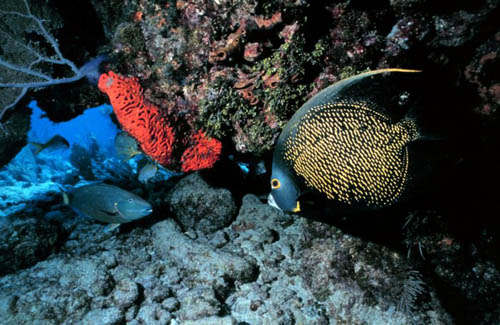
Food Habits
As an omnivore, this fish feeds on a wide range of algae and invertebrates. The juveniles feed on algae and detritus along with ectoparasites they clean from other fishes. They tend “cleaning stations” where they remove these ectoparasites from a wide range of fishes including jacks, snappers, morays, grunts, surgeonfishes, and wrasses. Juvenile angelfish swims with a fluttering motion at cleaning stations and, during cleaning events, touches the body of the clients with its pelvic fins.
Adult French angelfish primarily feed on sponges as well as tunicates, zoanthids, corals, gorgonians, and algae. Vase sponges often show v-shaped scars from past angelfish bites.
Reproduction
Spawning occurs from April through September. French angelfish have been observed spawning over deep reef areas in the early morning hours. Pairs of these fish cruise several feet above the reef which involves a few short chases between the pair. If other French angelfish approach the pair too closely, they are quickly chased away. The pair swims slowly, rising in the water column, bringing their vents close together and releasing eggs and sperm into the water. During each spawning event, approximately 25,000-75,000 eggs are released. This activity is then repeated. The pelagic eggs are spherical and transparent with a diameter of 0.9mm. Eggs hatch approximately 15-20 hours after fertilization. The larvae live among plankton until they reach approximately 15mm where upon they settle onto the coral reef. The post-larvae are dark-colored with pigmented vertical bars.
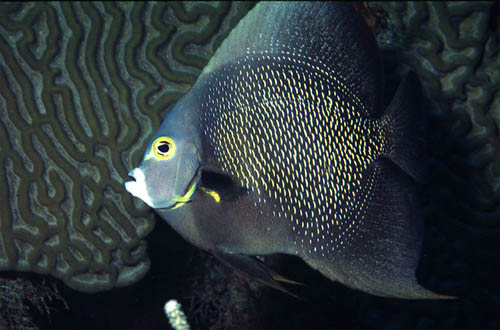
Parasites
A parasitic monogenean has been reported from the foregut of captive French angelfish.Predators
Large fishes are potential predators of the French angelfish.
Taxonomy
This fish was originally described as Chaetodon paru in 1787 by German ichthyologist Marcus Bloch. Bloch is well known for his volume “Natural History of Fishes” which was published in 1785. The French angelfish was reclassified by later workers as Pomacanthus paru (Bloch 1787).